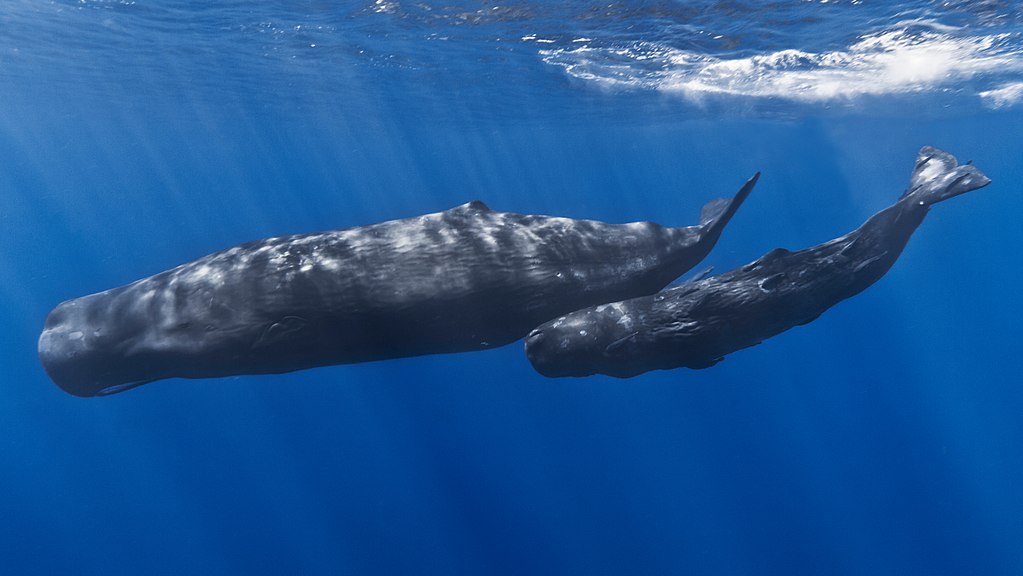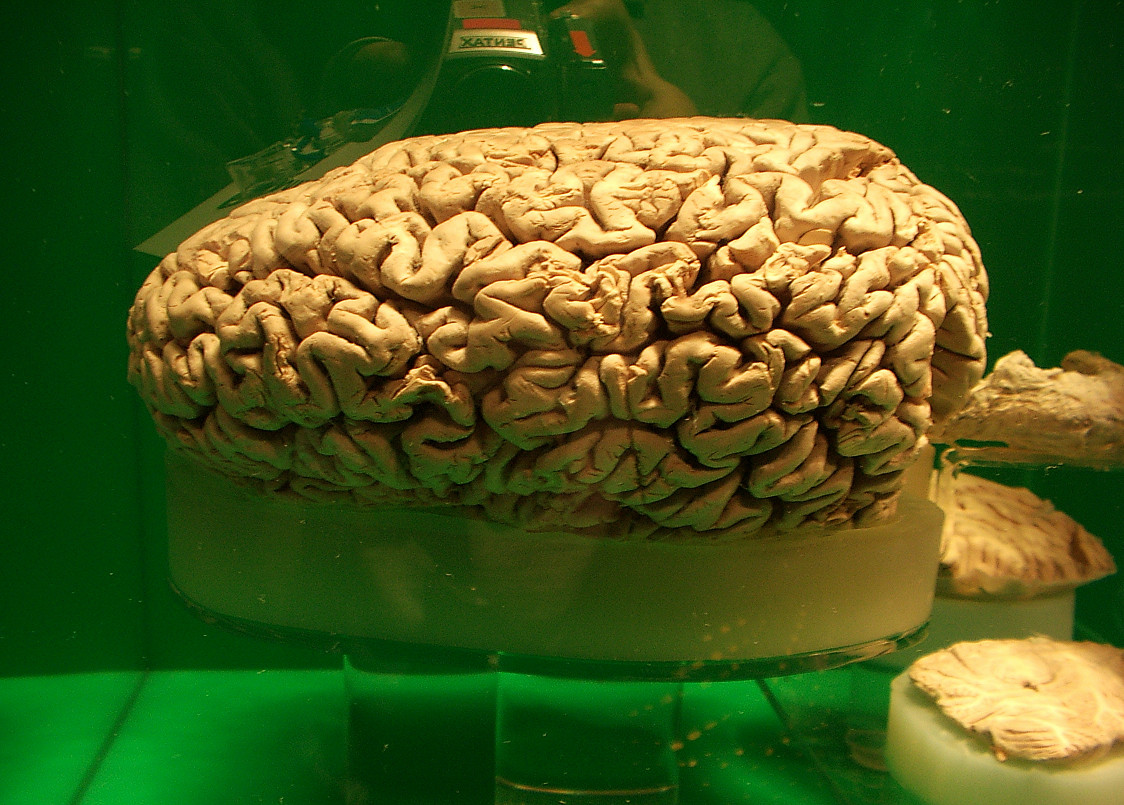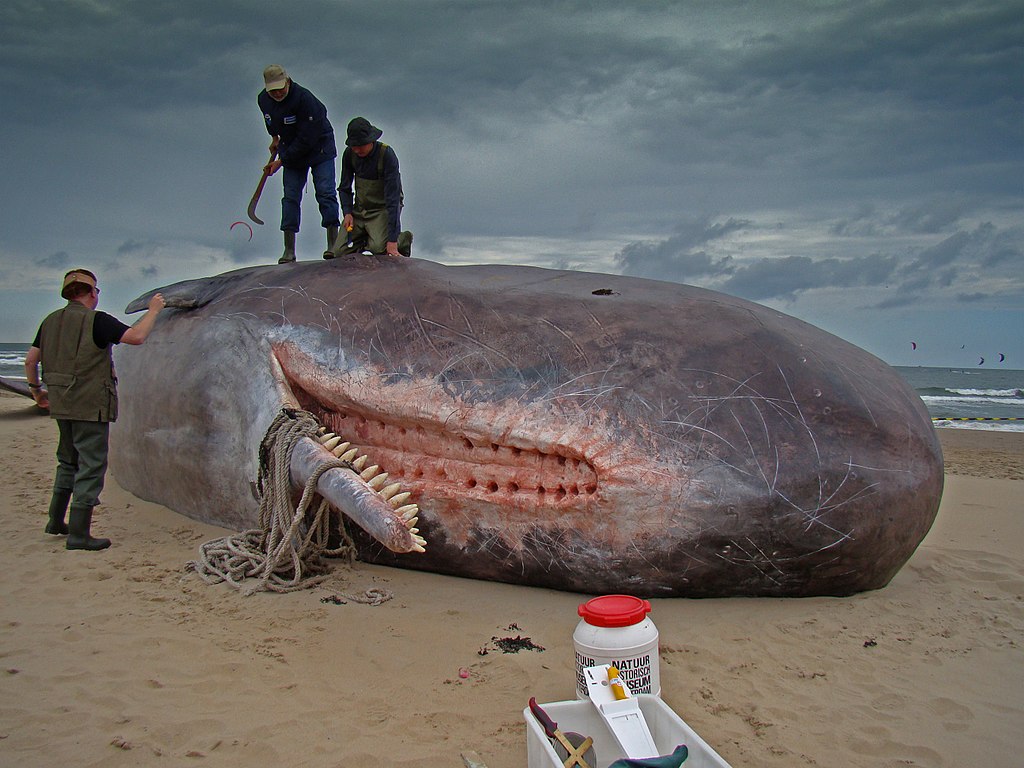Sperm whale
The sperm whale (Physeter macrocephalus) is the largest of the toothed whales and the largest toothed predator in the world. It is the only living member of genus Physeter and one of three extant species in the sperm whale family, along with the pygmy sperm whale and dwarf sperm whale of the genus Kogia.
The sperm whale is a pelagic mammal with a worldwide range, and will migrate seasonally for feeding and breeding. Females and young males live together in groups while mature males live solitary lives outside of the mating season. The females cooperate to protect and nurse their young. Females give birth every four to twenty years, and care for the calves for more than a decade. A mature sperm whale has few natural predators, although calves and weakened adults are sometimes killed by pods of orcas.
Mature males average 16 meters (52 ft) in length but some may reach 20.5 meters (67 ft), with the head representing up to one-third of the animal's length. Plunging to 2,250 meters (7,382 ft), it is the second deepest diving mammal, following only the Cuvier's beaked whale. The sperm whale is a prominent user of echolocation and communication, with vocalization as loud as 230 decibels (re 1 µPa at 1 m) underwater.[6] It has the largest brain of any animal on Earth, more than five times heavier than a human's. Sperm whales can live for more than 60 years.
Spermaceti oil (called "sperm" for short), from which the whale derives its name, was a prime target of the whaling industry, and was dominant for use in oil lamps, lubricants, and candles. Ambergris is a solid waxy waste product from its digestive system. It is still highly valued as a fixative in perfumes and other uses. It remains as flotsam from deceased whales, and is sought by beachcombers. The species is now protected by a whaling moratorium, and is currently listed as vulnerable by the International Union for Conservation of Nature (IUCN).
Description
The sperm whale is the largest toothed whale, with adult males measuring up to 20.5 meters (67 ft) long and weighing up to 57,000 kilograms (56 long tons; 63 short tons). By contrast, the second largest toothed whale (Baird's Beaked Whale) measures 12.8 metres (42 ft) and weighs up to 15 short tons (14,000 kg).
Extensive whaling may have decreased their size, as males were highly sought, primarily after World War II. Today, males do not usually exceed 18.3 meters (60 ft) in length or 51,000 kilograms (50 long tons; 56 short tons) in weight. Another view holds that exploitation by overwhaling had virtually no effect on the size of the bull sperm whales, and their size may have actually increased in current times on the basis of density dependent effects. Old males taken at Solander Islands were recorded to be extremely large and unusually rich in blubbers.
It is among the most sexually dimorphic of all cetaceans. At birth both sexes are about the same size, but mature males are typically 30% to 50% longer and three times as massive as females.
The sperm whale's unique body is unlikely to be confused with any other species. The sperm whale's distinctive shape comes from its very large, block-shaped head, which can be one-quarter to one-third of the animal's length. The S-shaped blowhole is located very close to the front of the head and shifted to the whale's left. This gives rise to a distinctive bushy, forward-angled spray. The sperm whale's flukes (tail lobes) are triangular and very thick. Proportionally, they are larger than that of any other cetacean, and are very flexible. The whale lifts its flukes high out of the water as it begins a feeding dive. It has a series of ridges on the back's caudal third instead of a dorsal fin. The largest ridge was called the 'hump' by whalers, and can be mistaken for a dorsal fin because of its shape and size.
In contrast to the smooth skin of most large whales, its back skin is usually wrinkly and has been likened to a prune by whale-watching enthusiasts.
Brain
The brain is the largest known of any modern or extinct animal, weighing on average about 7.8 kilograms (17 lb), more than five times heavier than a human's, and has a volume of about 8,000 cm3. Although larger brains generally correlate with higher intelligence, it is not the only factor. Elephants and dolphins also have larger brains than humans. The sperm whale has a lower encephalization quotient than many other whale and dolphin species, lower than that of non-human anthropoid apes, and much lower than humans'.
The sperm whale's cerebrum is the largest in all mammalia, both in absolute and relative terms. The olfactory system is reduced, suggesting that the sperm whale has a poor sense of taste and smell. By contrast, the auditory system is enlarged. The pyramidal tract is poorly developed, reflecting the reduction of its limbs.
Sleeping
For some time researchers have been aware that pods of sperm whales may sleep for short periods, assuming a vertical position with their heads just below or at the surface. A 2008 study published in Current Biology recorded evidence that whales may sleep with both sides of the brain. It appears that some whales may fall into a deep sleep for about 7 percent of the time, most often between 6 p.m. and midnight.
Distribution
Sperm whales are among the most cosmopolitan species. They prefer ice-free waters over 1,000 meters (3,300 ft) deep. Although both sexes range through temperate and tropical oceans and seas, only adult males populate higher latitudes. Among several regions such as along coastal waters of southern Australia, sperm whales have been considered to be locally extinct.
Sperm whales are usually found in deep, off-shore waters, but may be seen closer to shore, in areas where the continental shelf is small and drops quickly to depths of 310 to 920 meters (1,020 to 3,020 ft). Coastal areas with significant sperm whale populations include the Azores and Dominica. In Asian waters, whales are also observed regularly in coastal waters in places such as Commander and Kuril Islands, Shiretoko Peninsula where is one of few locations whales can be observed from shores. Grown males are known to enter surprisingly shallow bays to rest (whales will be in state of rest during these occasions). There are unique, coastal groups reported from various areas among the globe such as Scotland, Shiretoko Peninsula, off Kaikoura, in Davao Gulf. Such coastal groups were more abundant in pre-whaling days.
Diet
Sperm whales usually dive deep in search of food. Such dives can last more than an hour. They feed on several species, notably the giant squid, but also the colossal squid, octopuses, and fish such as demersal rays, but their diet is mainly medium-sized squid. Some prey may be taken accidentally while eating other items. Most of what is known about deep sea squid has been learned from specimens in captured sperm whale stomachs, although more recent studies analysed feces. One study, carried out around the Galápagos, found that squid were the most common animal eaten. Battles between sperm whales and giant squid or colossal squid have never been observed by humans; however, white scars are believed to be caused by the large squid. One study published in 2010 collected evidence that suggests that female sperm whales may collaborate when hunting Humboldt squid.
Tagging studies have shown that sperm whales hunt upside down at the bottom of their deep dives. It is suggested that the whales can see the squid silhouetted above them against the dim surface light.
Predation
The most common natural predator of sperm whales is the orca, but pilot whales and false killer whales sometimes harass them. Orcas prey on target groups of females with young, usually making an effort to extract and kill a calf. The adults will protect their calves or an injured adult by encircling them. They may face inwards with their tails out (the 'marguerite formation', named after the flower). The heavy and powerful tail of an adult whale can deliver lethal blows. Alternatively, they may face outwards (the 'heads-out formation'). Other than sperm whales, southern right whales had been observed to perform similar formations. However, formations in non dangerous situations have been recorded as well. Early whalers exploited this behavior, attracting a whole unit by injuring one of its members.


